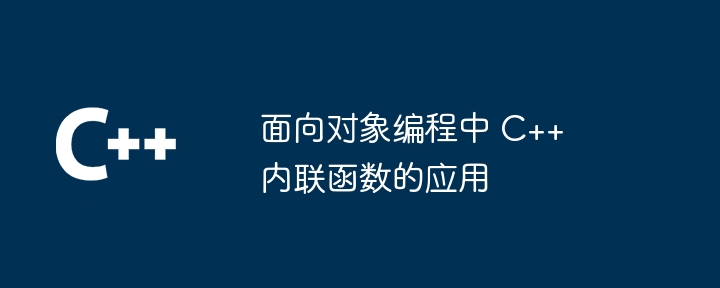
Inline functions are a useful tool for improving the efficiency of method calls in OOP because they are expanded at compile time, avoiding the overhead of function calls. When declaring an inline function, just add the inline keyword before the function definition. The advantages of inline functions include improved performance, reduced code size, and improved readability. However, when using it, you need to pay attention to potential code bloat, increased compilation time, and optimizer interference.

C Application of inline functions in object-oriented programming
Inline functions are expanded at compile time, not every time A function that is re-executed when called. This can significantly improve program performance, especially when the function is called frequently. In object-oriented programming (OOP), inline functions are particularly useful because they make method calls more efficient.
Declaration of inline functions
To declare an inline function, just add the inline keyword before the function definition. For example:
inline int square(int x) {
return x * x;
}Advantages of inline functions
Inline functions have the following advantages:
Practical case
Consider a class that calculates the area of a circleCircle:
class Circle {
public:
double radius;
// 计算面积
inline double area() {
return 3.14159 * radius * radius;
}
};In this case, area Methods are declared as inline functions. This means that every time an area method is called, the compiler expands the function body at the call site. This improves program performance because the compiler does not have to create new stack frames or make function calls for area methods.
Notes
Although inline functions have many benefits, there are also some considerations:
Overall, inline functions are a valuable tool in C OOP to improve method calling efficiency and program performance. However, when using inline functions, you should consider its advantages and caveats.
The above is the detailed content of Application of C++ inline functions in object-oriented programming. For more information, please follow other related articles on the PHP Chinese website!
 What is an inline function
What is an inline function
 What are the differences between c++ and c language
What are the differences between c++ and c language
 Recommended learning order for c++ and python
Recommended learning order for c++ and python
 Cost-effectiveness analysis of learning python and c++
Cost-effectiveness analysis of learning python and c++
 Is c language the same as c++?
Is c language the same as c++?
 Which is better to learn first, c language or c++?
Which is better to learn first, c language or c++?
 The difference and connection between c language and c++
The difference and connection between c language and c++
 C++ software Chinese change tutorial
C++ software Chinese change tutorial




